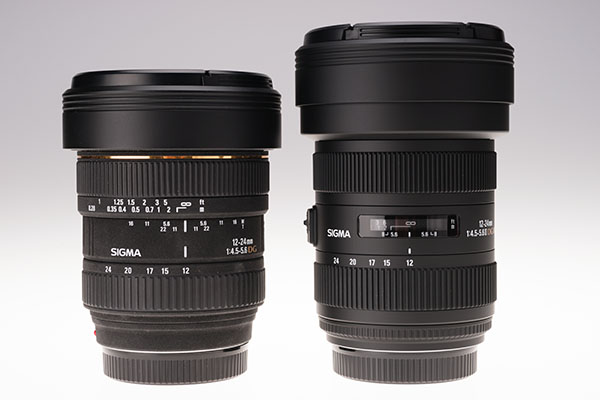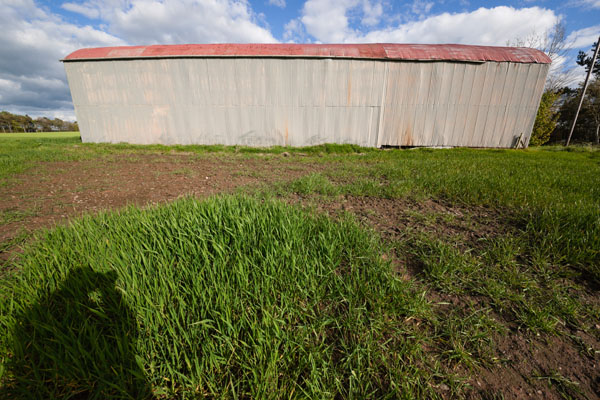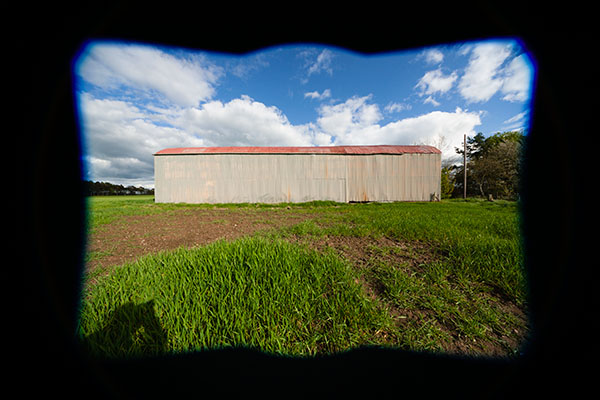Sigma ultrawide zooms – old and new 12-24s versus 8-16mm
For almost a decade the Sigma 12-24mm full frame ultra wide angle zoom has been unrivalled by any other makers – not Nikon, not Canon, not Tamron, not Tokina, not Sony. No maker has ventured where Sigma went, to the extremes of over 120° coverage combined with well corrected straight line geometry.
Today, the original 12-24mm is in its fourth incarnation, having progressed through EX to EX DG (digital) and then with added HSM hypersonic motor focusing, which never arrived for Alpha mount in the original design. The fourth version is an entirely new design, and does have HSM for Alpha. It is very similar to the new 8-16mm design, introduced three years ago for APS-C cameras, which also offers HSM focusing in Alpha mount.
Update five years later, 2017: there is now a constant aperture 12-24mm f/4 ART lens. This is a completely new design and has an almost-perfect performance, especially in terms of corner detail wide open. I’ve tested it in Cameracraft magzine. However, I did not have the various older models to make direct comparisons. The MkII remains available as the current non-ART, lower priced Sigma option.
Here you can see, from left to right, the EX DG 12-24mm f/4.5-56, the DC 8-16mm f/4.5-5.6, and the DG HSM II 12-24mm f/4.5-5.6. Don’t be fooled into thinking the original is wider in diameter, it actually shares exactly the same lens cap module as the new design; it’s smaller and around 100 grams lighter. Both the 8-16mm and new 12-24mm are surprisingly solid items.
First, we’ll look at the difference between old and new 12-24mms. I have used the old one in several versions on several different camera makes. and I’ve never had one which was truly sharp at all point across the frame wide open. The field is not perfectly flat, and autofocus modules are very bad at getting an exact focus at 12mm. Combined with lens mount tolerances, sensor flatness problems (mostly in Canon full-frame, which historically have not had very ‘plane’ sensors), sensor parallelism problems (all makes, Sony not excepted)… it was always a good idea to stop this lens down to f/11.
How bad is that? Perfectly normal for any lens covering over 85°. Even the best large format lenses, single focal lengths like Super Angulons, have always been used in the awareness that full aperture is for focusing and you stop down to between f/11 and f/32 for the actual shot. On 35mm format digital, using anything much below f/16 is counter productive for sharpness and my normal choices on the Alpha 900 have been f/10, f/11, or f/13.
The good news is that the latest version has a different kind of field flatness. The old one tended to have a zone, like a doughnut, of closer effective focus surrounding a sharp middle. At 24mm, where this older lens performed at its worst, this zone was pushed out to the far edges and could result in the corners looking softer than they do at 12mm. The new one has a simple barrel distortion in place of a wave-form distortion, and along with this goes a simple curvature of field.
The bad news is that the overall level of distortion is much higher than the old design. At 12mm, it’s close to needing the fingers of two hands. Adobe Camera Raw had a correction profile for this lens from Sigma almost the day it became available. That profile fixed the distortion perfectly but leaves you slightly less of a 12mm than you’ve paid for, because it reduces the angle of view.
Here are some comparative views. First of all, I’ve used only 10 megapixels of the Alpha 900 frame, cropping from the top of a vertical shot, to get this architecturally correct view. This is like using the 12-24mm as an extreme 12mm shift lens on an APS-C camera. As and when we get a 36 megapixel Alpha full framer, the crop to do so will be more like 16 megapixels. This is the full frame:
Below you can see the crop used to 10 megapixels, and by rolling your cursor over the image, the change between a profiled conversion and a raw conversion with no lens corrections. On this crop it does not look extreme.
But this is a relatively kind way to use the new lens. Here is an example pushing straight lines into places where extreme wide angles don’t like ’em:
This is an uncorrected 12-24mm DG II HSM shot out of the Alpha 900 at 12mm. It’s not exactly what you want, and in fact, it’s not as ‘good’ as the old design despite being sharper. Hovering your cursor over the image shows the same raw file with the Adobe Camera Raw Sigma-generated Lens Profile (also works in Lightroom) applied. As you will see, straight lines have been restored along with even illumination. But – how much of that 12mm, 122° angle has been lost? Is it now really only a 12.5mm?
In practice, the new 12-24mm gives you a great range of creative choices when confronted with a building. Here is a revisit to the first subject, taken at different focal lengths, getting closer to the building with each shot:
24mm
20mm
17mm
15mm
12mm
When it comes to comparisons with the older design, the new one is much sharper at the edges. It does not need stopping down to f/16 to pull in the worst aberrations, though it does still display some around f/8 to f/11. Here’s an original 12-24mm EX DG design shot (12mm, f/9, vignetting corrected but distortion not corrected):
And here’s the new 12-24mm under the same conditions (small exposure difference due to changing light) processed similarly, without any geometric corrections:
On this shot, the corrugated barn sides have clean ribbing to the extreme ends, with some softening; on the old design, they begin to look a bit of a mess in the outer quarter of the frame.
Trying the 8-16mm extreme
But when doing these tests, I decided to throw a novelty into the mix. What if I put my 8-16m APS-C format Sigma DC HSM zoom on to the Alpha 900? Because it is not an Alpha lens, the 900 does not automatically crop the full frame. This is what I actually got with the lens set to 8mm:
And in Adobe Camera Raw, I just dialled up the Scale in Lens Correction to 146%, which blew up the central 12 or so megapixels of the frame to become a full 24 megapixel image:
And here, for comparison, is what the 12-24mm set to 12mm could produce:
This is a little tighter than the 8mm using the maximum I could get (including some extra image height), so the 8-16mm used this way can produce something closer to an 11.5mm full frame lens. However, I have not yet done the obvious – to get an engineer to remove the petal lens shade from the 8-16mm (it appears to be part of the front element assembly). This would enable even more angle without shading, and the possibility of square or 10 x 8 shape format crops.
What was particularly interesting about this experiment was the quality of the 24 megapixel file extracted from a smaller section of the Alpha 900 sensor by Adobe Camera Raw upscaling. Full size files are available to download for subscribers to Photoclubalpha – it’s well worth the $10 for a full year of access to any of the extras we provide. See the download links at the end of the article, which will become visible if you are a registered subscriber to the site.
The 8-16mm also achieves full frame coverage on the Alpha 900 when set to 16mm, though with fairly marked vignetting:
Here are some more samples from the 12-24mm DG II HSM: first, 17mm at f/8 – no geometry correction:
Next, at 12mm at f/13 which on the A900 seems to be the limit for good detail sharpness without extra effort in processing:
And 17mm at f/22 – beyond the diffraction limit, but processed carefully for detail:
And 12mm at f/9, an optimum setting for detail with plenty of depth of field for this subject:
So, what was my own decision? I own the 8-16mm and an Alpha 77. That’s what I use for travel and general work. I own an original EX DG 12-24mm. I decided not to buy the new 12-24mm because I concluded that the 8-16mm used on APS-C was effectively as good. The angle is not quite a match for the 12-24mm on full frame, as APS-C is not a true 16 x 24mm. For those occasions where a 12-24mm on full frame is needed, I’m nearly always able to work on a tripod at f/13 and focus manually (which overcomes most of the issues with the earlier lens). Since it needs less drastic geometric correction, it offers a very small angle of view advantage over the new lens in return for the risk of poor sharpness if not used well stopped down. I have no doubt the new lens is better, but it’s not £400 better which is what the ‘trade-up’ would cost – and the old lens is lighter and smaller, which I appreciate.
The test made me even happier with the 8-16mm, especially with the thought that some modification could make it a unique lens to use on the Alpha 900 or a future full frame EVF model (A99). After doing these tests, I decided it was not necessary to take the Alpha 900 and a 12-24mm despite the investment in two weeks’ shooting in the Sierras and Pacific Coast of California – the A77 and 8-16mm would do everything I needed.
But for those buying a 12-24mm, for full frame on any system, the new Sigma represents even better performance than the 8-16mm (better edge and corner sharpness at one stop down from wide open) and has none of the failings of the older lens even if it does need more post-process geometry correction.
Download full size images [private] 24 megapixels 12-24mm EX DG at 12mm f/9 Download Link
Download full size image 24 megapixels 12-24mm DGII HSM same as above Download Link
Download full size image 24 megapixels 8-16mm lens scaled to 24 megapixels from A900 ‘crop’ Download Link
Download full size image 24 megapixels 12-24mm DGII at 12mm compared to 8-16mm at 8mm cropped Download Link
Download full size image 24 megapixels 8-16mm at 16mm filling full A900 sensor Download Link
Download full size image 24 megapixels 17mm f/8 fence example shot boat Download Link
Download full size image 24 megapixels 12mm f/13 sequoia tree example shot Download Link
Download full size image24 megapixels 17mm f/22 boat Download Link
Download full size image24 megapixels 12mm f/9 riverside tree Download Link [/private]
To check the weight, specifications and other details of these three lenses we suggest you visit Sigma’s own site – for the new 12-24mm, here’s the UK site info. And here is the 8-16mm, which they oddly don’t class under wide zooms, but under DC lenses.
You can check worldwide shipped prices from B&H Photo in New York.
– David Kilpatrick






















